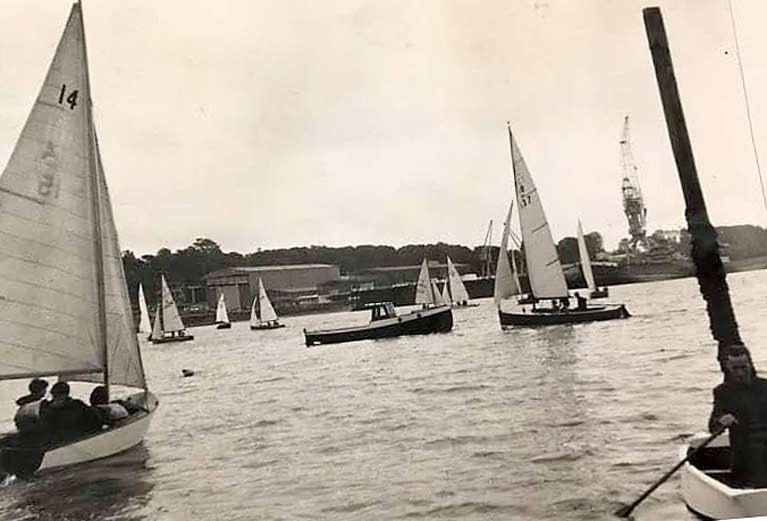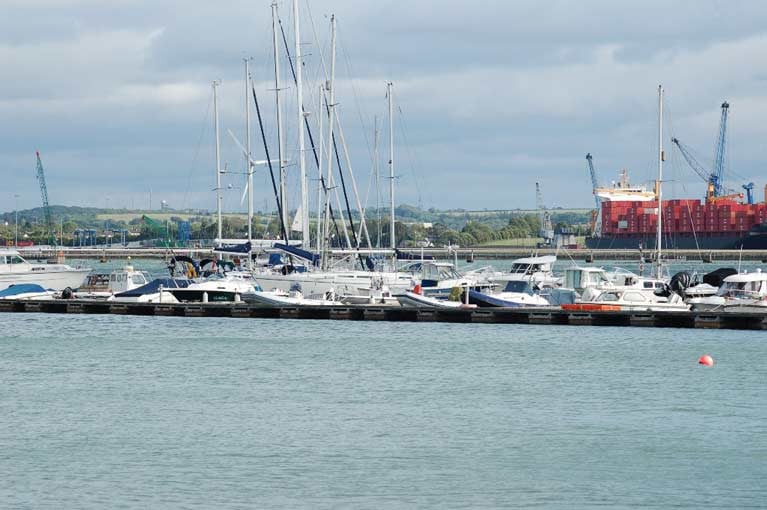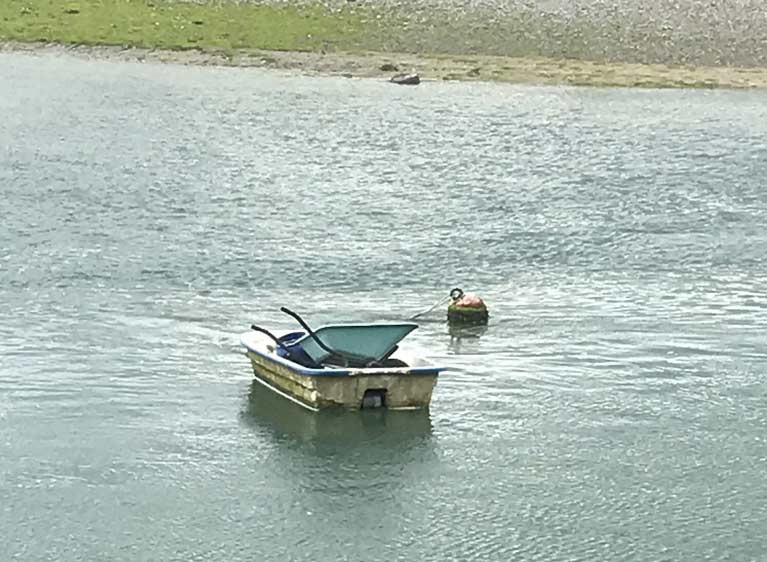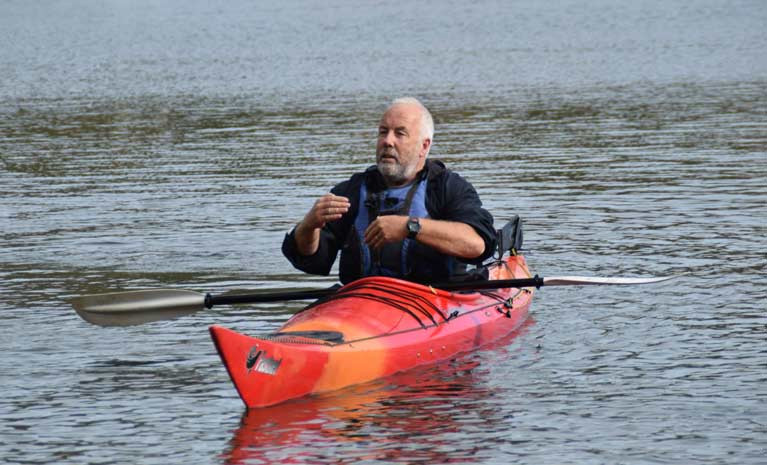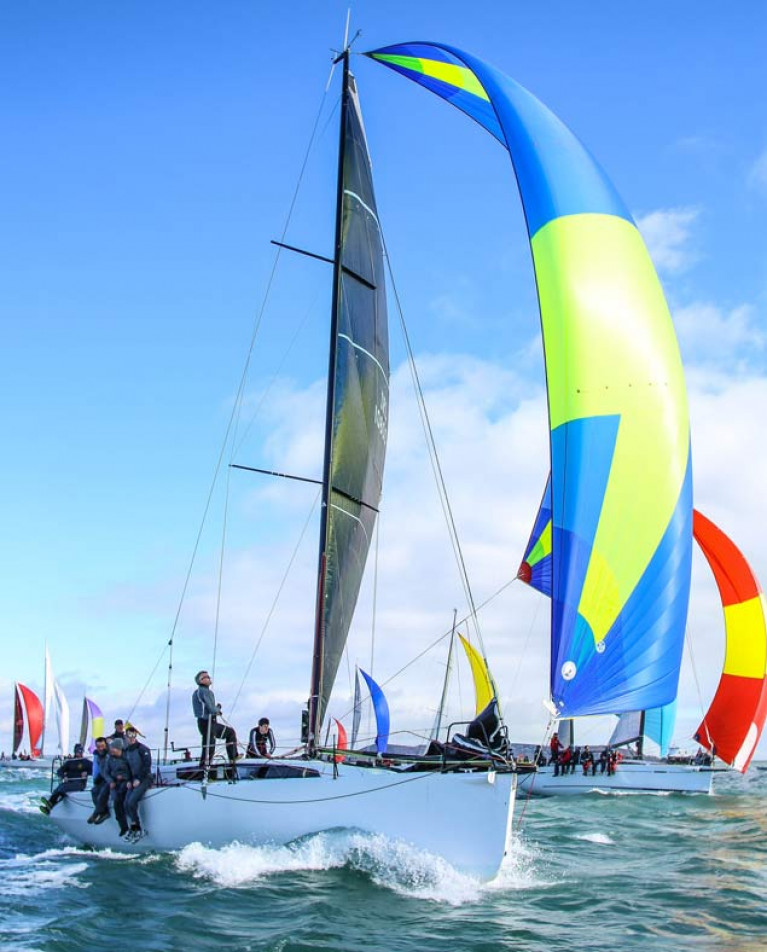Displaying items by tag: Cork Harbour
Time was when fifty years seemed a long time in the life of any sports organisation, and indeed in life itself. Golden Jubilees were a big deal, to be celebrated with much fanfare. In fact, even 25 years of organisational continuity were worthy of festivities. But then, the general mindset was programmed by the fact that many sports only became properly codified towards the end of the 1800s, while the organisations which grew from them were generally only finding their feet around the turn of the century in 1900.
The new Century was barely under way before it was riven by two World Wars, in 1914-1918 and again in 1939-1945. In between them, in Ireland in the period 1919 to 1922 we managed to fit in a War of Independence, Partition and a Civil War. None of this was remotely comparable in scale to the major geopolitical changes and industrial carnage of the global conflicts, but they caused major disruption and tragedy at a local and personal level, such that just one decade of civilised life and gentle progress began to seem like a long time, a major achievement.
Yet despite the Troubles in Ireland between 1969 and 1998, the general mood since the end of World War II in 1945 has been one of peace and progress, however deceptive that may become under close analysis. The effect of all this – allied to markedly increased longevity until too many people started getting obese in recent years – is that fifty years no longer seems such a very long time.
 An unrivalled heritage afloat. Willem van der Hagen’s 1736 painting of Cork Harbour with the then-unextended though fortified Haulbowline Island at centre, showing at last seven yachts of the Water Club in the group of vessels heading towards the channel past Cobh. Courtesy RCYC
An unrivalled heritage afloat. Willem van der Hagen’s 1736 painting of Cork Harbour with the then-unextended though fortified Haulbowline Island at centre, showing at last seven yachts of the Water Club in the group of vessels heading towards the channel past Cobh. Courtesy RCYC
We see it in Irish sailing in particular by noting the number of people around us who can remember participating in the Quarter Millennial Celebrations of the Royal Cork Yacht Club in 1969-1970, and were looking forward to being involved in the RCYC’s Tricentenary this year.
Back in 1970 – which after all was only 25 years after the end of World War II - fifty years still seemed a very considerable length of time, making the Royal Cork’s 250 year of existence all the more remarkable. That was something which was underlined ten years later, when much fanfare accompanied the Irish Cruising Club’s Golden Jubilee Cruise-in-Company in 1979, with a large international fleet sailing westward from Crosshaven to the incomparable cruising grounds of southwest Ireland, made popular over the years by the key ICC founder, Harry Donegan of Cork.
 The 1895-designed Cork Harbour OD Imp making full speed seawards in the 1950s. When the new Class Association was formed in 1896, Harry Donegan – the very personification of Cork sailing enthusiasm - was its first secretary. He also was a formidably successful helmsman in a CHOD, he took part and placed third in the first Fastnet Race in 1925 in his 17-ton cutter Gull (becoming a founder member of the Royal Ocean Racing Club), and in 1929 he played the key role in founding the Irish Cruising Club, starting with a cruise-in-company westwards from Cork Harbour, and concluding with the formation of the ICC in Glengarriff. In addition to his many achievements afloat and ashore, he was a talented painter of marine subjects. Photo: Tom Barker
The 1895-designed Cork Harbour OD Imp making full speed seawards in the 1950s. When the new Class Association was formed in 1896, Harry Donegan – the very personification of Cork sailing enthusiasm - was its first secretary. He also was a formidably successful helmsman in a CHOD, he took part and placed third in the first Fastnet Race in 1925 in his 17-ton cutter Gull (becoming a founder member of the Royal Ocean Racing Club), and in 1929 he played the key role in founding the Irish Cruising Club, starting with a cruise-in-company westwards from Cork Harbour, and concluding with the formation of the ICC in Glengarriff. In addition to his many achievements afloat and ashore, he was a talented painter of marine subjects. Photo: Tom Barker
But nowadays, fifty years is something we just take in our stride. And perhaps it is this modern compression of the half-century which has helped us to cope with the unbelievable reality that the visionary and meticulous plans for the Tricentenary of the RCYC have been up-ended by a worldwide pandemic, a lethal disease which originated in a wet market in the depths of China, and has spread so totally and ruthlessly across the world that we will probably never really know the true extent of its fatal effects.
Preventing those dreadful effects from being even worse has become a national project. Yet before the need for this became totally clear, even the most utterly pessimistic observer could not have imagined how totally the necessary safety measures would effectively wipe out the RCYC celebrations.
Sailing is of itself a very healthy sport, and the people who participate in it are usually from a vigorous cohort of the population. But that in turn means that our post-sailing socialising is unusually intense. So we know that the resumption of sailing is requiring a complete re-set of the way we go about our activities afloat, and how we access them. But meanwhile, the thoughts of the sailing community are very much with the sailors of Cork, and the way that their hopes and plans were caught precisely in the target cross-hairs of the spreading pandemic.
Yet the way that the Royal Cork YC has responded to this unbelievable reversal of fortune has been an inspiration to us all. The inevitable cancellations have been timely and efficient, and the members have rallied round in a spirit of mutual support, while Admiral Colin Morehead has been the very model of calm philosophical acceptance and example as he leads his members in handling this extraordinary challenge.
 Colin Morehead, Admiral of the Royal Cork Yacht Club, whose calm and philosophical acceptance of the effects of Lockdown, after he had devoted three years to planning the Tricentenary, has been much admired in sailing. His sense of the continuity of Cork sailing is emphasized by the marine artwork he has chosen to be photographed with – it is one of Harry Donegan’s paintings of a Cork Harbour OD. Courtesy RCYC
Colin Morehead, Admiral of the Royal Cork Yacht Club, whose calm and philosophical acceptance of the effects of Lockdown, after he had devoted three years to planning the Tricentenary, has been much admired in sailing. His sense of the continuity of Cork sailing is emphasized by the marine artwork he has chosen to be photographed with – it is one of Harry Donegan’s paintings of a Cork Harbour OD. Courtesy RCYC
Colin Morehead himself had been working on the plans for the Tricentenary for three years and longer, and while he was doing that, it was Pat Farnan as Admiral who led the club to such good effect through the busy countdown years that RCYC entered 2020 already feted as “Club of the Year”.
It was all systems go, and then it was all systems on hold as the grim news came from the east, and then with gruesome inevitability, it was all crowd-gathering events on cancellation. Yet it was done with a dignity and graceful acceptance which set the standard not just for Irish clubs, but for world sailing generally.
It is impossible to overestimate the beneficial effect which the gallant –indeed noble – manner in which the RCYC has dealt with the circumstances has contributed to the general good. Then too, the broad benefit of the community spirit within the club has manifested itself in many ways, with the National 18 class leading the charge in the full development of eRacing, while members with a real feeling for the extraordinary history of the club have got together to produce an online series - Way Back When – which features on the RCYC website, and explores many areas of club activity and Crosshaven history, all with an attractive personal touch.
Limited club sailing has of course finally resumed this week in controlled circumstances with emphasis on the juniors, while family sailing – always central to the Cork scene – has been returning as the restrictions are eased, though there’s still a long way to go, and everyone is mindful of the need for careful monitoring at every stage.
 The History of the Royal Cork YC was published in 2005 when it was honoured as “Irish Book of the Year”. Written by historian Alicia St Leger, it was based on the club’s unrivalled collection of artefacts, documents, memorabilia and sailing records curated by Honorary Archivist Dermot Burns
The History of the Royal Cork YC was published in 2005 when it was honoured as “Irish Book of the Year”. Written by historian Alicia St Leger, it was based on the club’s unrivalled collection of artefacts, documents, memorabilia and sailing records curated by Honorary Archivist Dermot Burns
What with the fresh look at the club’s past through the Way Back When series, coupled with the fact that the Club’s monumental history - based by historian Alice St Leger on RCYC archivist Dermot Burns’ unrivalled collection of records and artefacts going back to 1720 and beyond - was published to several awards and much acclaim in 2005, provides an enduring base of shared awareness. This, when combined with the eRacing, the Webinars, and now the ordered resumption of sailing in gradual socially-distanced steps, tells us all that the RCYC is very much alive and well.
In fact, nothing has become the Royal Cork Yacht Club so much as its graceful acceptance of the inevitability of cancelling much of its Tricentenary celebrations. It tells us much about how the Club and its members have matured and thrived over the centuries into the unique institution which has been a club for long enough to be planning a Tricentenary in the first place. As sailing resumes on a broader scale, the RCYC will find that their standing in world sailing is greater than ever.
As it is, they should take every encouragement from the progress that they and their magnificent harbour have made in terms of facilities and activity since 1970, which becomes abundantly clear from most of 1970’s monthly editions of Irish Yachting & Motorboating, Afloat.ie’s direct predecessor, which in 1970 was dominated by the RCYC Quarter Millennium.
 Lead page from the June 1970 Irish Yachting & Motorboating, featuring Denis Doyle and Sir Francis Chichester inspecting the new Gipsy Moth V under construction in Crosshaven Boatyard
Lead page from the June 1970 Irish Yachting & Motorboating, featuring Denis Doyle and Sir Francis Chichester inspecting the new Gipsy Moth V under construction in Crosshaven Boatyard
 Two men of the sea in serious mood – Denis Doyle and Francis Chichester considering Gipsy Moth V’s new-style fin-and-skeg configuration, with the 7-ton keel cast in Dublin. At such moments when cameras were about, Chichester was obliged to look serious, but in fact he regarded Crosshaven as one of his favourite places to relax and enjoy.
Two men of the sea in serious mood – Denis Doyle and Francis Chichester considering Gipsy Moth V’s new-style fin-and-skeg configuration, with the 7-ton keel cast in Dublin. At such moments when cameras were about, Chichester was obliged to look serious, but in fact he regarded Crosshaven as one of his favourite places to relax and enjoy.
We really started to roll with the May issue, in which the lead item in Seascape, the opening collection of stories of particular interest to the Editor, led with the building of Francis Chichester’s 53ft Robert Clark-designed Gipsy Moth V in Crosshaven Boatyard. I hadn’t forgotten just how much Chichester had loathed the committee-designed Gipsy Moth IV in which he circled the world in 1966-67 with one stop at Sydney, but I had forgotten - until re-reading the story fifty years down the line - that he’d been so impressed with the improvements Sydney yacht designer Warwick Hood had made to the boat during the Sydney stopover that he at one stage contemplated getting Hood to design Gipsy Moth V.
However, in the end he went back to Robert Clark, designer of Gipsy Moth III which had been built by Tyrrell of Arklow, and as Clark by this stage had formed a working relationship with Crosshaven Boatyard through Denis Doyle, that’s where Gipsy Moth V was built.
 Crosshaven built, and looking well. Gipsy Moth brought a refreshing simplicity and clarity of design with a notably good sailing performance after the complications and problems of Gipsy Moth IV
Crosshaven built, and looking well. Gipsy Moth brought a refreshing simplicity and clarity of design with a notably good sailing performance after the complications and problems of Gipsy Moth IV
When we all went back to Crosshaven in July through various offshore races finishing in Cork Harbour, Gipsy Moth V was afloat and Francis Chichester was in the village and having himself a fine old time among the crews who took part in the week-long Quarter Millennia Offshore Regatta which followed the feeder races.
This relaxed state of affairs came to an end when Mary Doyle took the nautical knight up to Cork Airport to meet an incoming flight with the formidable Sheila Chichester on board. The plane pulled up on the apron outside the Terminal Building, and almost immediately a distinctive red trouser leg emerged from the opening door. Chichester whispered to Mary: “Oh dear. That’s the trouser suit we were knighted in at Greenwich. I think the fun is over for a day or two.”
Meanwhile, everyone else continued to have much sport and fun throughout the Cork summer of 1970, but in looking back at those magazines of the time, the abiding impression is of the greyness of it all, mainly because black and white photos were still totally dominant, but also there’s the primitive nature of the facilities.
 The Royal Cork YC’s clubhouse in 1970, with the long sloping jetty across the mud in the foreground. Photo: W M Nixon
The Royal Cork YC’s clubhouse in 1970, with the long sloping jetty across the mud in the foreground. Photo: W M Nixon
The Royal Cork clubhouse was only a tiny hint of what it has become today, though I do rather miss the old bar – originally from the time of the Royal Munster YC – which was in the shape and spirit of the great aft cabin of a mighty ship from the Golden Age of sail, but it wasn’t remotely commodious enough for today’s level of business.
As to getting afloat, it had been by a long jetty across mud – incredibly adhesive mud, as revellers would learn from time to time - and then by dinghy or club launch to your moored yacht out in the Owenboy River. However, by the time of the special regattas of 1969 and 1970, a large floating pontoon had been assembled at the club, and there was limited -though for many boats tide-sensitive - rationed berthing there.
 The beginnings. This first partially tidal pontoon was in place for the Quarter Millennium in 1969-70, but it wasn’t until 1974 that the RCYC had the beginnings of its marina, yet it was the first club marina in Ireland. Photo W M Nixon
The beginnings. This first partially tidal pontoon was in place for the Quarter Millennium in 1969-70, but it wasn’t until 1974 that the RCYC had the beginnings of its marina, yet it was the first club marina in Ireland. Photo W M Nixon
Yet it wasn’t until 1972 that Ireland saw the first salt-water marina, and that was a local council amenity at Coleraine on the estuary of the River Bann on the North Coast.
But then 1974 the Royal Cork installed the beginnings of its marina, a new-fangled and very popular Autumn league followed that same year as a consequence, and since then progress has been taking place on almost every coastline - despite what some still-deprived areas might think - and it is Cork Harbour which has been leading the way.
This has been fulfilling an historic tendency. After all, the Water Club of the Harbour of Cork came into being partially because the landowners around the harbour sometimes found the most convenient way to get about his complex area of water and into the city was by boat, and it didn’t take long for working boats used for personal transport to be developed into something more luxurious.
Then the age of steam brought a new wave of harbour transport, with routes criss-crossing the harbour, and steamer piers and landing stages being installed at strategic locations, with many of them – or the remains of them - still in evidence. Local railways did provide an alternative, and so too did roads and cars as both improved, but the steamers survived for a remarkably long time.
When John G Sisk, who recently featured here as the first owner of Sarnia, was a schoolboy in Cork during the upheavals and dangerous strife of the early 1920s, for his safety he lived in his parents’ house in Myrtleville, travelling home by the harbour steamer to Crosshaven each evening and then continuing by pony and trap the two miles to the house.
Being John G Sisk, he optimised this situation. He knew that he would spend some time on the early morning steamer going back up to Cork city next day, so he was able to spend his evenings roaming freely in boyish adventures in the fields and beaches of Myrtleville, knowing he’d a clear time-slot for his homework on the morning ship to school.
 Cork Harbour Paddle Steamer in the Port of Cork. They gave convenient access to piers and landing stages strategically located all round the harbour
Cork Harbour Paddle Steamer in the Port of Cork. They gave convenient access to piers and landing stages strategically located all round the harbour
All round Cork Harbour you can see the remains of the old steamer call-points, and there are many other little local ancient harbours too, some so old their original uses are forgotten. For a while, indeed, it seemed that the great days of Cork Harbour as an amenity, every bit as much as it’s a commercial asset, had been forgotten too.
But that has changed in the past fifty years, and particularly the past twenty. The Port of Cork and the Council have been beavering away installing landing and berthing facilities at key locations through this myriad island-filled harbour, transforming it for mini-cruising, for although there are real beaches in some choice locations, elsewhere mud is still king, and getting neatly and cleanly ashore at a safe berth makes all the difference in visits to the islands and remote locations.
 Cork Harbour 1970, when there were very few officially-recognized berthing and landing facilities
Cork Harbour 1970, when there were very few officially-recognized berthing and landing facilities
 Cork Harbour 2020 is very much work in progress, with most years seeing significant additions to landing and berthing facilities. 2020’s big breakthrough will be Cove Sailing Club’s new marina at Cobh which is currently being installed, thereby bringing the Harbour’s marina total up to six - or seven if you count the extensive berthing facilities available in Cork City itself, and eight if you add in the Naval Yacht Squadron’s berthing in Haulbowline. Imaging: Jack O’Keeffe
Cork Harbour 2020 is very much work in progress, with most years seeing significant additions to landing and berthing facilities. 2020’s big breakthrough will be Cove Sailing Club’s new marina at Cobh which is currently being installed, thereby bringing the Harbour’s marina total up to six - or seven if you count the extensive berthing facilities available in Cork City itself, and eight if you add in the Naval Yacht Squadron’s berthing in Haulbowline. Imaging: Jack O’Keeffe
The two people who lead the movement in making the best possible use of everything that Cork Harbour now has to offer are Monkstown’s Jack O’Keeffe, who’s busy with Drascombes when he’s not busy with kayaks when he’s not on some project involving Meitheal Mara (with it sometimes being a combination of all three), and Eddie English of Cobh. Eddie’s webinar this week, providing a guide to every hidden corner of this fantastic history-laden harbour, was required viewing, an eye-opener for anyone whose knowledge of Cork Harbour is restricted to biennial participation in Cork Week.
 The Drascombe that gets to places the locals didn’t even know existed – Cork Harbour guru Jack O’Keeffe racing single-handed in the Dun Laoghaire Harbour Bicentenary Regatta in 2017. Photo: W M Nixon
The Drascombe that gets to places the locals didn’t even know existed – Cork Harbour guru Jack O’Keeffe racing single-handed in the Dun Laoghaire Harbour Bicentenary Regatta in 2017. Photo: W M Nixon
 Eddie English’s First 36.7 Holy Grounder at Blackrock Castle in the upper harbour
Eddie English’s First 36.7 Holy Grounder at Blackrock Castle in the upper harbour
Jack O’Keeffe put together the remarkable “Corkumnavigation” of Cork city by kayaks and paddleboards last weekend, a real adventure which took the participants from crowded city-centre quaysides with visiting naval vessels looming over them, right into what seemed like the deepest heart of the countryside with trees closing overhead above clean narrow and winding waterways, while at other times they were going through a cityscape which might have been Venice.
 It mightn’t quite be Venice, but who’d have thought this was an area of Cork City directly accessed from the sea by last weekend’s Corkumnavigation. Photo: Jack O’Keeffe
It mightn’t quite be Venice, but who’d have thought this was an area of Cork City directly accessed from the sea by last weekend’s Corkumnavigation. Photo: Jack O’Keeffe
 There are parts of Cork Harbour which seem very distant indeed from the open sea, and this is one of them, reached in Cork City during last weekend’s Corkumnavigation. Photo: Jack O’Keeffe
There are parts of Cork Harbour which seem very distant indeed from the open sea, and this is one of them, reached in Cork City during last weekend’s Corkumnavigation. Photo: Jack O’Keeffe
Next weekend, Jack is leading a Drascombe flotilla around the harbour, and he’s to give an illustrated talk on the Inner Harbour to Meitheal Mara shortly, so it was time to update available data. It’s thanks to him that we have the interim gazetteer of landing and berthing facilities around Cork Harbour, for it’s such a complex place with so many small local developments taking shape that it needs constant monitoring by people like Jack just to keep up.
No better man. On Wednesday evening, I was supposed to be phoning him at home to discuss how this was all coming together, the idea being that he’d be comfortably at his desk slurping a cup of tea or something stronger, and comfortably able to take the ideas forward. But while there was a semi-liquid noise when I got through, it was a squelching rather than a slurping, and he seemed slightly breathless.
 Drascombes are the Heineken boats – they reach the places the others can’t. This is the “lost” harbour of Carrickgremman on Little Island. Photo: Jack O’Keeffe
Drascombes are the Heineken boats – they reach the places the others can’t. This is the “lost” harbour of Carrickgremman on Little Island. Photo: Jack O’Keeffe
“Don’t mind me” he said. “I’ve just heard about a tiny hidden Cork Harbour beach I didn’t even know about, and I just had to go and see for myself. I’m nearly there, and I think I can see a little patch of sand. If you don’t get some photos from me later tonight, you’ll know it was quicksand….”
The photos arrived. But what with Jack boldly going where no skipper had ever gone before, and the unquenchably enthusiastic Eddie English taking his First 36.7 Holy Grounder into places where most of us wouldn’t take a paddleboard, we’ve serious Cork Harbour information overload. So you’ll just have to go and see for yourselves, confident that if Lockdown continues in some limited form, there’s already an entire cruising universe within Cork Harbour without having to even think about going out to sea.
 A convenient facility to provide access to a fascinating place - the landing pontoon on Spike Island, with Cobh resplendent beyond. Photo: Jack O'Keeffe
A convenient facility to provide access to a fascinating place - the landing pontoon on Spike Island, with Cobh resplendent beyond. Photo: Jack O'Keeffe
And in all its glory, the place is another expression of the continuing spirit of the Water Club of the Harbour of Cork as expressed through the Royal Cork Yacht Club and all the other clubs around this unique area of sheltered scenic water. In this time of travail, we wish them well, and thank them profoundly for the fine example they’ve set for sailors everywhere.
 Calm morning in a busy harbour. The aerial view from above Paddy’s Point along the causeway towards Haulbowline with the Naval Base complete with Yacht Squadron marina, and Cobh beyond with a cruise liner in port. Photo: Port of Cork
Calm morning in a busy harbour. The aerial view from above Paddy’s Point along the causeway towards Haulbowline with the Naval Base complete with Yacht Squadron marina, and Cobh beyond with a cruise liner in port. Photo: Port of Cork
2020 was to be a year of special events in Cork Harbour. COVID 19 brought those plans to a crashing halt. The highest-profile hit was Cork Week and the events celebrating Cork 300, many of which are cancelled or in doubt at present. But tucked away in another part of the harbour lies a special club that had its very own anniversary this year.
Monkstown Bay Sailing Club came into being on Sunday, the 7th of June 1970. The six-strong committee of Mr Robert Cuppage, Mr Jack O’Driscoll, Mr Barry O’Connell, Mr Will O’Brien and Mr Dick Woodley was ably led by Mr Norcott Roberts.
Racing initially took place in Enterprises and other small dinghies on a handicap basis. The races were held in the evenings. The minimum subscription was 10/- which made you a founding member.
The village of Monkstown has always featured a strong sense of community and no place exemplifies this more than Monkstown Bay Sailing Club. Many families of founding members are still actively involved in the running of the club and as the club has grown in stature a full programme is conducted every year with no one left out. Class 1 and 2 dinghies still race of an evening and an active cruiser fleet races also.
 Monkstown Bay's first sailing course
Monkstown Bay's first sailing course
One of the first events organised by the club was an IYA sailing course. 40 aspiring young sailors attended, and the course was run by Mr Neville Eames.
To this day the courses have run introducing countless sailors to the pleasures and delights of sailing on Cork Harbour. In another consequence of the current pandemic, for the first time, in living memory, the sailing course has been cancelled. The sight of boats being rigged on a sunny morning by enthusiastic sailors will be sorely missed on the daily commute to work.
By way of compensation for the loss of the celebratory weekend, Monkstown Bay Sailing Club has commemorated their anniversary with a series of posts and commentary on their Facebook page and a series of WhatsApp messages to those members who are signed up to the various club groups.
In one of the initial posts, the twenty-seventh Commodore, Mr Ciarán Mc Sweeney greeted the membership with a wonderful letter commemorating the club’s anniversary and went on to announce the re-commencement of racing within guidelines in July for class 1 and a slightly restricted version for class 2.
It is also intended to run some training for level 3 and 4 junior sailors to complete their certificates.
Looking further ahead the club will exhibit items of historical interest in the Passage West Maritime Museum later in the year when it reopens. It is also noted that the anniversary celebrations have merely been postponed and an opportunity to celebrate will be taken later in the year as circumstances permit.
With 22km winds howling around Cork Harbour last Saturday morning, the Ocean to City team should have been in a frenzy reorganising the race routes, but instead, they were online in the middle of launching their Ocean to City Virtual Challenge. From the comfort of their homes the organisers did a countdown for over a hundred participants, from all over the world, who were getting ready to row Ocean to City on their rowing machines.
At 10.30 am the Zoom screens were filled with participants from Ireland, UK, Portugal, USA, Australia, Germany and Lebanon. Race Director Donagh MacArtain began the event talking about the difficult decision to cancel this year’s race and thanking those who supported and continue to support the Cork Harbour Festival: Cork City Council, Cork County Council, Port of Cork, Fáilte Ireland and many more who have ensured the future of the festival and Ocean to City. Lord Mayor of Cork City, Cllr. John Sheehan joined in the Zoom meeting to formally welcome all participants. The Lord Mayor spoke on the importance of a collective in these strange times and how vital it is to bring people together. He remembered starting his term as Lord Mayor launching the Lee Swim and how apt it was to finish it with the Ocean to City.
The event had two categories to choose from, the Rowing Machine Challenge – where participants rowed the equivalent time to either the Ocean Course (2hr23min39sec) or the Monkstown Course (1hr1mins12secs). The furthest distance rowed within the time limit would win. The second category was the Fun Time challenge – where participants had to record their most creative rowing or paddling training on land. The event was also joined by UK runner Lawrence Washington who ran for the full Ocean Course time limit, from his home to the town of Porthmadog and back.
The race began at 11am and stayed live on Facebook and Zoom where spectators could watch the efforts of the participants in the rowing challenge. Along with the rowing challenge, participants were asked to send in videos of their creative home training and the submissions were fantastic! All submitted videos are available on oceantocity.com along with the full results on the day.
The 16th Ocean to City was a very different day but thankfully the day and the ethos of this wonderful race was marked, as a community of like-minded people who have a love of the water, of Cork and the spirit to adapt to new circumstances.
Ocean to City – An Rás Mór, the flagship event of Cork Harbour Festival is organised by Meitheal Mara, the community boatyard, training centre and charity located in the heart of Cork City. The event is sponsored by Cork City Council, Cork County Council, Port of Cork, Fáilte Ireland and made possible with the help of dozens of Event Partners and hundreds of volunteers.
Cork Harbour Festival will be back next year 5-13 June 2021 with the flagship Ocean to City – An Rás Mór taking place on Saturday 5 June 2021.
I'd Like to Go Yacht Racing This Season - But...
The sight of more masts appearing on the marina in my village of Monkstown on the edge of Cork Harbour was encouraging this week. Not that I have any disregard for the motorboat community who populate the Cork Harbour Marina year-round, but in this difficult and challenging season, it was good to see more yacht masts in the marina and other yachts going onto their moorings in Monkstown Bay.
That was the good news. The disappointing news was from Sail Training Ireland that they have had to cancel all Tall Ship voyages planned for this year.
Chief Executive Daragh Sheridan said this was inevitable because there was no way the organisation “could ensure the social distancing required to ensure the safety of trainees and crew.”
That is the issue which troubles me about the resumption of cruiser yacht racing.
The Government’s medical advisors and the Minister for Health have been making it clear that, as Mr.Harris has said: “social distancing will be with us for a long time.”
How can social distancing be achieved on a racing yacht?
Two metres is just over six feet, even one metre would be difficult, “impossible” is the description I’ve heard repeatedly in phone calls and read in Emails.
Two instances this week highlighted my thoughts about this “social” or “physical distancing.” One was when I was reminded of a 30-year anniversary and the lack of any “social distance” on my only TransAtlantic race, back in May 1990 as a crew member aboard NCB Ireland on the last leg of that year’s Round the World Race, then known as the Whitbread, from Fort Lauderdale to Southampton - 3,818 nautical miles sailed over 18 days. The crew shared “hot bunking”. Mine was the middle of three where when lying down there wasn’t enough space to raise a book to read.
Social or physical distancing wasn’t possible on the 83-foot NCB and I can’t see it either on Scribbler, the 33-foot Sigma which I sail with my son, grandsons and occasional other crew. We won’t even qualify as a family crew because we are in two households.
 Yacht Racing at the 2019 Volvo Dun Laoghaire Regatta Photo: Afloat
Yacht Racing at the 2019 Volvo Dun Laoghaire Regatta Photo: Afloat
Irish Sailing are doing their best, but there seems little official understanding of the requirements of sailing. How do you keep apart during the demands of racing, when more than one person may be needed to get a sail in or to launch and recover a spinnaker, or what about adding weight on the rail?
Solo racing will be ok, but there aren’t a preponderance of single-household cruiser racing crews, or so it appears from the reaction I’m receiving. Even with the easing of restrictions, the constant message is that social distancing stays in place…. So can cruiser racing be resumed?
All the comments I’m getting seem to be doubtful unless there are major changes in social distancing. I hope there are because I’d like to go sailing and racing this season.
This week’s Podcast is below...
Mystery Wheel-Barrow in Cork Harbour Boat Raises Concerns for Seafood Seller Molly Malone
An untended wheelbarrow apparently abandoned in a boat at Ringabella at the entrance to Cork Harbour has raised concerns about the well-being of the noted Dublin-based seafood distributor, Ms Molly Malone. An outstanding figure in the Dublin retail food-to-go scene, Ms Malone is noted for her special skills in the use of wheel-barrows for the rapid distribution of live seafood, notably cockles and mussels. It is believed that she may have gone to Cork to inspect new sources of supply which will live up to the business mission statement of her wares being “Alive, Alive-Oh”.
While conspicuous in her retail role, Ms Malone is noted for keeping her activities under cover when developing agencies for resourcing her popular products. Thus even her closest colleagues were unaware that she might have gone to Cork to broaden her network. And while the authorities are keeping an open mind about the situation, the Gardai and the Irish Coastguard would welcome any information from any source whatever about the possible whereabouts of Ms Malone (whose photo they have distributed), and they assure Afloat.ie that they will keep the media and the public abreast of all developments.
 Noted Dublin-based seafood distributor Ms Molly Malone – worries are being expressed regarding her whereabouts in Cork
Noted Dublin-based seafood distributor Ms Molly Malone – worries are being expressed regarding her whereabouts in Cork
Two Cork Sailing Clubs Plan Return to ‘Limited Racing’
The problem for resuming normal yacht racing is the current limitation on household crewing of boats only. Because the majority of yachts are not crewed solely by one household, racing is impossible under current restrictions. This is reflected in the intentions of two Cork clubs to resume limited racing, for household-crewed boats only, reports Tom MacSweeney.
Kinsale Yacht Club's limited form of club sailing
Kinsale Yacht Club is proposing to start what Club Commodore Mike Walsh describes as “a limited form of club sailing next Wednesday (June 10) but only for family/ household boats living within 20kms of the club marina. This would include Squibs, Dragons, Cruisers.”
He has told members that this racing “will be limited to white sail only for cruisers.
“All activities are limited to household units. If there is sufficient interest we will continue this league or series of races until July 20. Starting and finishing will be from the club marina.”
The club intends to start its Junior Sailing/training course on July 6, which is likely to run to the end of August in a restructured schedule. The course is fully booked. Further applications will be put on a waiting list.
 Loch Greine, owned by Tom, Donal and Declan O'Mahony sailing past Roches Point Lighthouse Photo: Bob Bateman
Loch Greine, owned by Tom, Donal and Declan O'Mahony sailing past Roches Point Lighthouse Photo: Bob Bateman
 Cruiser racing in Cork Harbour Photo: Bob Bateman
Cruiser racing in Cork Harbour Photo: Bob Bateman
Cove Sailing Club's single-handed or single household sailing
Cove Sailing Club in Cork Harbour says it is aiming to resume sailing at the start of July, “assuming government restrictions are lifted at the end of June.”
This also will only be for “single-handed or single household sailing.”
 Cove Sailing Club Headquarters Photo: Bob Bateman
Cove Sailing Club Headquarters Photo: Bob Bateman
The club says it will not be able to run “a full programme of training courses similar to the past 13 years, but will endeavour to plan for a return to sailing courses as soon as safely possible.”
Afloat's Lorna Siggins will interview kayaker Jim Kennedy of Atlantic Sea Kayaking as part of an online celebration of Cork Harbour starting tomorrow.
Although the physical Cork Harbour Festival was cancelled due to Covid-19, organisers Meitheal Mara are featuring an online celebration of Cork Harbour and Ireland’s maritime culture, which is now in full swing and continues until Monday 8th of June 2020.
Festivities began on the 15th of May, the original start date of the festival, and include live Facebook & Zoom events, videos, tutorials, craft projects, an Ocean to City Virtual Challenge and much more. The full programme of this year’s online celebration, as well as recordings from past events, are online at corkharbourfestival.com. The next seven days will see the following events:
 Jim Kennedy at the Fastnet Rock. Photo: Valerie Sullivan
Jim Kennedy at the Fastnet Rock. Photo: Valerie Sullivan
Interview with Jim Kennedy of Atlantic Sea Kayaking
Tuesday 2 June, 20:00 - Interview with Jim Kennedy of Atlantic Sea Kayaking, by Lorna Siggins, print & radio reporter and former Irish Times marine correspondent.
Jim Kennedy is passionate about all things Irish, especially coastal and marine wildlife, stories, music, adventure tourism and of course kayaking. He has raced on the Irish National Kayaking team at two sprint and two marathon world championships, won an Irish rowing Championship with Lee Rowing Club and is a level 5 Irish Canoe Union sea kayak instructor/coach. Drawing on his wealth of experience, Lorna will ask Jim about his tips on how to prepare for a race like Ocean to City; what his training programme for the world’s toughest survival and endurance race, the Yukon 1000, looks like; and what places we should definitely put on the bucket list for when this lockdown is over.
Ocean to City Virtual Challenge
Saturday 6 June, 11:00 - Ocean to City Virtual Challenge
We are delighted to bring you “The Ocean to City Virtual Challenge” a fun, energetic and creative way to celebrate the rowing and paddling community that was built up over the past 16 years. With safety foremost you are invited to pick a challenge that matches your ability. The event has two categories to choose from, the Rowing Machine Challenge - where participants see how far they can row in a specified time, and a Fun Challenge - where participants are asked to show their most creative rowing or paddling training on land. For more information, see www.oceantocity.com. Deadline for registration is Thursday 4 June.
The Alliance of Pirates, Ireland and Atlantic Piracy
Monday 8 June, 13:10 - Lunchtime Lecture with UCC School of History & Dr Connie Kelleher, ‘The Alliance of Pirates, Ireland and Atlantic Piracy’. Curated by Dr John Borgonovo.
In the early part of the seventeenth-century, along the southwest coast of Ireland, piracy was a way of life. Dr Connie Kelleher will explore who these pirates were, their main theatre of operations and the characters that aided and abetted them. Archaeological evidence uniquely supports the investigation and provides a tangible cultural link through time to the pirates, their cohorts and their bases. Dr Connie Kelleher works with the National Monuments Service’s Underwater Archaeology Unit in the Department of Culture, Heritage and the Gaeltacht and is visiting lecturer the Department of Archaeology in University College Cork, delivering the course on the Introduction to Underwater Archaeology. Curated by Dr John Borgonovo.
 Poet Mick Delap celebrates the magnificence of the Atlantic coast
Poet Mick Delap celebrates the magnificence of the Atlantic coast
Sailor-poet Mick Delap celebrates the magnificence of the Atlantic coast
Monday 8 June, 20:30 - Ó Bhéal Poetry Event
Featured poets for Ó Bhéal’s third virtual event, part of Cork Harbour Festival, are Mick Delap and Alice Lyons. The evening will also include a five-word challenge and open-mic session. Sailor-poet Mick Delap celebrates the magnificence of the Atlantic coast, and chronicles different aspects of its history. In 2002 he won Best First Collection at Listowel for River Turning Tidal.
To join a live event one can either watch the live stream on the festival Facebook page facebook.com/corkharbourfestival/ or one can register for a Zoom invite at corkharbourfestival.com. All events are free to join.
The Port of Cork has announced the start of a new weekly direct service from Cork to USA, giving Ireland its first direct container service to the USA in many years.
The new Cork Harbour service is set to commence with the sailing of the ‘Independent Vision’ on June 6th. ICL will sail from the Port of Cork every Saturday arriving on the East Coast of the USA 10 days later, offering Irish exporters the most reliable and fastest delivery times for their supply chains.
CEO of the Port of Cork, Brendan Keating said: ‘The Port of Cork is delighted with this opportunity to work with ICL and support this new direct route to the US. The timing is perfect with the opening of our new €80 million Cork Container Terminal in Ringaskiddy on the horizon and has the potential to grow cargo volumes from and to Ireland. This is a fantastic strategic development for the Port of Cork as we look to develop Ringaskiddy as a modern logistics hub.’
CEO of ICL John Kirkland said: “Ireland is a market we have been keen to develop for a while and we sincerely hope the Irish trade support this commitment by ICL, to bring Ireland its first direct weekly service to the USA East Coast. We look forward to working with the Port of Cork with their exciting expansion plans”
ICL has been serving the North Atlantic trade for 35 years and is consistently named the most reliable carrier.
Cork Harbour sailor Jason Losty has recently been appointed to the Cowes Harbour Commission Board.
The Cove Sailing Club ace who was victorious in the Quarter Ton Corinthian Cup in 2014 with brother Dominic has since featured strongly in his First 36.7 Altair in division two of RORC events on the Solent over the past few seasons.
Losty, who enjoys racing small keelboats and cruising, was co-opted as a Commissioner for a period of 12 months. Losty started his Merchant Navy Career in 1998, serving on oil tankers and ferries. He subsequently moved to the oil and gas industry, fulfilling a variety of roles at sea and in shoreside management. He changed career path in 2017 to become a Southampton Pilot, making Cowes his home, according to the Commissioners.
New Date for Dublin Bay-Cork Harbour Race Brings Back Memories of Legendary Schooner America
The postponed date of Friday, July 31st is being considered as a feasible time to think of starting the ISORA-organised 160-mile Dublin Bay to Cork Harbour Race, which was originally planned for July 9th to link this summer’s celebration of the 150th Anniversary of Dun Laoghaire’s National Yacht Club with the massive Tricentenary Celebrations of the Royal Cork Yacht Club.
The COVID-19 lock-down and its aftermath may have wiped out or changed much of 2020’s keenly-anticipated major fixtures, with the SSE Renewables Round Ireland Race on 20th June from Wicklow postponed to August 22nd, while all the main Royal Cork regatta and championship events for July have been cancelled.
But now that the analyses of the disease and its treatment and progress are developing positively on a daily business, it has become a question of “when” rather than “if” on whether or not there can be a meaningful start of the 2020 sailing programme in the best of the summer months, while still adhering to nationwide health guidelines.
A port-to-port offshore race by its very nature involves much less shoreside infrastructure than a major regatta, and Dun Laoghaire’s Peter Ryan of the Irish Sea Offshore Racing Association, a key player in its renewed vitality in recent years, reckons ISORA can thus play a leading role in getting sailing going again, as the Association operates flexibly, and may even offer the slight possibility of a couple of shorter races earlier in July.
 In addition to his successful longtime involvement with ISORA, Peter Ryan was Commodore of the National Yacht Club when it won the Mitsubishi Motors Sailing Club of the Year Award for 2011.
In addition to his successful longtime involvement with ISORA, Peter Ryan was Commodore of the National Yacht Club when it won the Mitsubishi Motors Sailing Club of the Year Award for 2011.
Talking to Sailing on Saturday late this week, while Peter Ryan emphasised that his thoughts were speculative and entirely his own, he reckoned that thinking in terms of starting what would have been ISORA’s big one in 2020, the historic re-sailing of the path-finding 1860 offshore race from Dublin Bay to Cork, could be on the cards by Friday, July 31st.
“It gives a modern connection to such an extraordinarily historic event that running it would cheer everyone up after a period in which we’ve lost so much in so many ways,” says Ryan. “And it would fit in neatly with getting the Irish Sea fleets to Cork to be conveniently on station for the beginning of the four-day Calves Week at Schull on Tuesday, August 4th.
“Then too, it would still leave plenty of time for those who wish to return to the Irish Sea for the Welsh IRC Championship at Pwllheli from August 14th to 16th August. And it would provide a very useful qualifying race for those who need to build up their sea time for the SSE Renewables Round Ireland Race on August 22nd. So everything points to being ready to think in terms of the Dublin Bay to Cork Harbour Race on Friday, July 31st”.
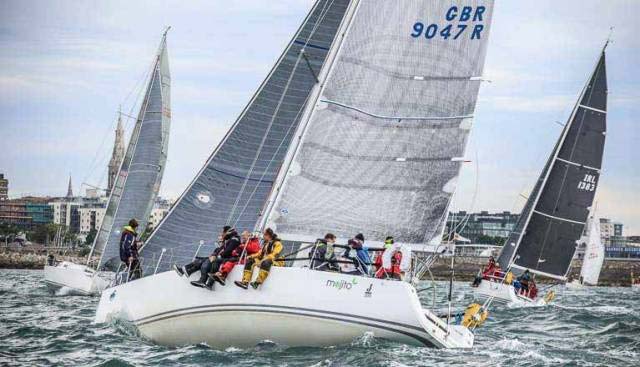 ISORA pre-start manoeuvres off Dun Laoghaire, with the successful Pwllheli-based J/109 Mojito (Peter Dunlop & Vicky Cox) in foreground. With a minimal requirement for shoreside infrastructure and organization, ISORA can be very flexible in modifying its programme. Photo: Afloat.ie/David O’Brien
ISORA pre-start manoeuvres off Dun Laoghaire, with the successful Pwllheli-based J/109 Mojito (Peter Dunlop & Vicky Cox) in foreground. With a minimal requirement for shoreside infrastructure and organization, ISORA can be very flexible in modifying its programme. Photo: Afloat.ie/David O’Brien
This is encouraging stuff, with the reassuring sense of quiet but thoughtful leadership at a time when it’s most needed. That said, the simple basic nature of ISORA’s functioning enables it to be nimble in adapting to changing circumstances. Yet in highlighting the significance of the Dublin Bay to Cork Harbour Race, Ryan definitely is associating his organisation and its revival of the sailing programme with sailing events of exceptional historical significance.
It was June 23rd 1861 when a distinctive 95ft schooner with markedly raked masts slipped into Cork Harbour and came to anchor off Cobh. She’d the look of a vessel which had recently sailed many offshore miles, but her congenial ship’s company were sailing under the burgee of the Royal Victoria Yacht of Ryde on the Isle of Wight, and they flew a well-used British ensign. So despite the absence of a properly-maintained ship’s log, the officials of this naval port accepted the schooner’s bona fides of being on an easygoing family cruise from the Solent to southwest Ireland, and accorded them the privileges which this conferred in terms of the waiving of harbour dues, while the Cobh-based Royal Cork Yacht and Royal Western of Ireland Yacht Clubs both made them welcome.
At the time Cobh – or Queenstown as it then was – was very much the hub of Cork Harbour sailing. For although there was a nascent club across on the western shore at Monkstown, it was 1872 before it became the Royal Munster Yacht Club, while Crosshaven was a tiny fishing port, with one of the few yachts about the place being the Newenham family’s 25-ton cutter Mask, lying to her moorings upriver on the Owenabue River.
 The Sirius Arts Centre in Cobh. Originally the 1854-completed Royal Cork YC clubhouse, it was here that the first Dublin Bay to Cork Harbour Race of 1860 finished, and where the crew of the mysterious schooner Camilla were made welcome on June 23rd 1861.
The Sirius Arts Centre in Cobh. Originally the 1854-completed Royal Cork YC clubhouse, it was here that the first Dublin Bay to Cork Harbour Race of 1860 finished, and where the crew of the mysterious schooner Camilla were made welcome on June 23rd 1861.
But Queenstown was buzzing, for in July 1860 the Royal Cork Yacht Club, under the enthusiastic guidance of its 80-year-old Admiral Thomas G French, had led the way in the inspiration for the first proper offshore race in British and Irish waters. The Royal St George Yacht Club in Dublin Bay had organized a week of regattas in early July, and after they’d concluded, no less than 16 boats – of very varied size and type – had accepted Admiral French’s challenge of racing the 160 miles to Cork, and it started on the 14th July.
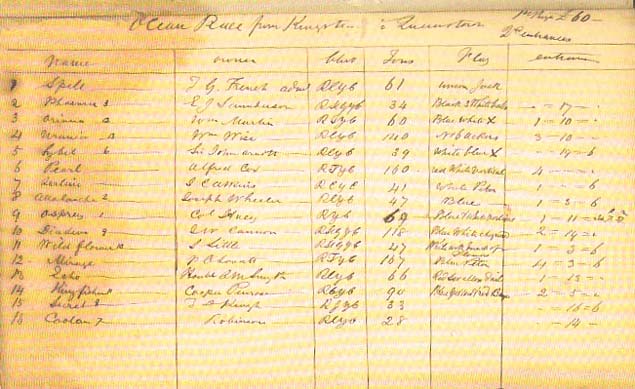 The Entry List for the second race of 1861 was very much an ad hoc affair, with RCYC Admiral Thomas French encouragingly visiting each boat pre-start in Kingstown, and confirming their entry and the fee paid on this list, believed to be written in his own hand. Image courtesy RCYC
The Entry List for the second race of 1861 was very much an ad hoc affair, with RCYC Admiral Thomas French encouragingly visiting each boat pre-start in Kingstown, and confirming their entry and the fee paid on this list, believed to be written in his own hand. Image courtesy RCYC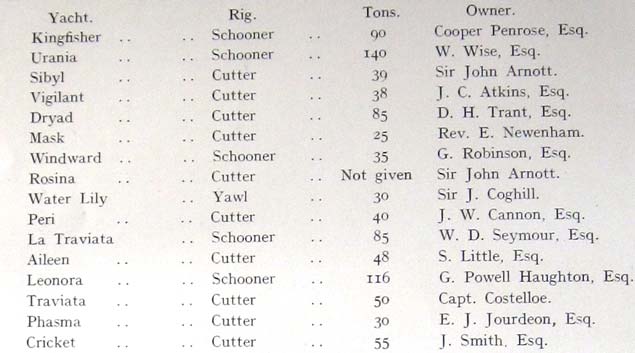 Printed version of the entry list for the first race of 1860 as it appeared in H P F Donegan’s History of Yachting in the South of Ireland, published 1908. Sir John Arnott certainly hedged his bets – he had two entries, and one of them, Sibyl helmed by the amateur Capt. Henry O’Bryen, was the winner
Printed version of the entry list for the first race of 1860 as it appeared in H P F Donegan’s History of Yachting in the South of Ireland, published 1908. Sir John Arnott certainly hedged his bets – he had two entries, and one of them, Sibyl helmed by the amateur Capt. Henry O’Bryen, was the winner
Much of it was raced in rugged windward conditions, but light airs prevailed at the finish off the Cobh waterfront for a real knife-edge conclusion, with Sir John Arnott’s 39-ton cutter Sybil – designed and built on Cork Harbour by Joseph Wheeler of Lower Glanmire – winning line honours and the race by three minutes from J.W.Cannon’s 40-ton cutter Peri, with Cooper Penrose’s 90-ton schooner Kingfisher another two minutes astern of Peri.
Sybil was skippered by the amateur ace Captain Henry O’Bryen, who had reputedly relinquished the helm for a total of only one hour during the race, a triumph for Corinthianism before it had became profitable or popular, if we may mix metaphors for a moment.
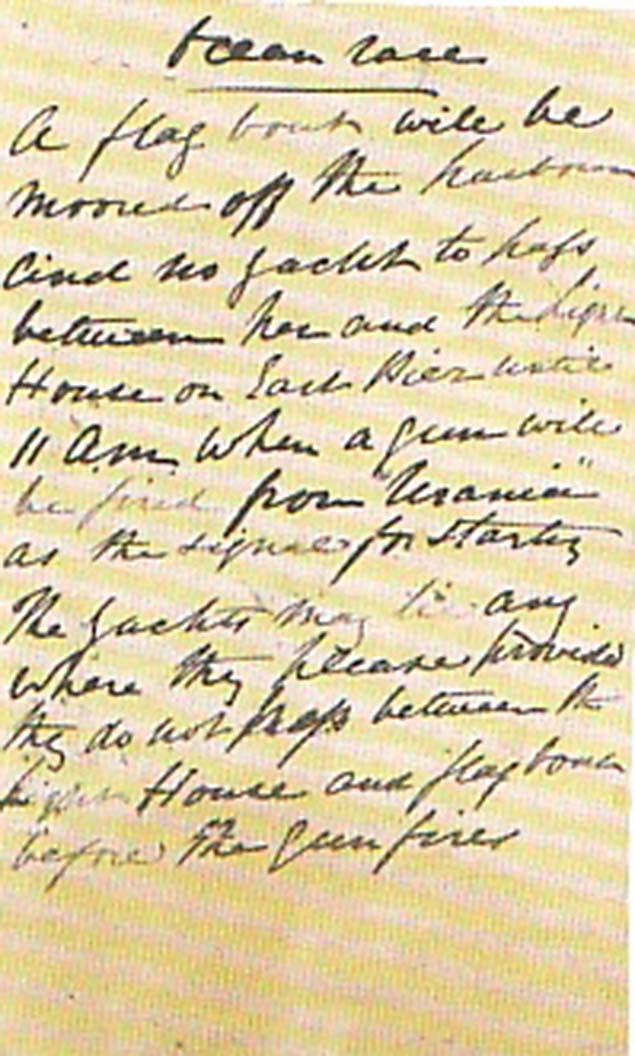 The hand-written Race Instructions for 1860 were also on a “make it up as you go along” basis. It reads: “Ocean Race. A flag boat will be moored off the harbour, and no yacht may pass between her and the Light House on the East Pier until 11 am, when a gun will be fired from “Urania” as the signal for starting. The yachts may lie where they please provided they do not pass between the Light House and flag boat before the gun fires”.
The hand-written Race Instructions for 1860 were also on a “make it up as you go along” basis. It reads: “Ocean Race. A flag boat will be moored off the harbour, and no yacht may pass between her and the Light House on the East Pier until 11 am, when a gun will be fired from “Urania” as the signal for starting. The yachts may lie where they please provided they do not pass between the Light House and flag boat before the gun fires”.
But Sybil’s owner Sir John Arnott (1814-1898) was something else, a real go-getting Scottish-born entrepreneur who’d arrived into Cork in 1837 aged 23 and launched himself into a sometimes rocky commercial career which at various stages involved heavy investment in department stores in Ireland and Scotland, horse racing both as an owner of thoroughbreds and of noted race courses, steamship companies, railways, and for a while the inevitable newspapers, in his case The Northern Whig in Belfast and The Irish Times in Dublin.
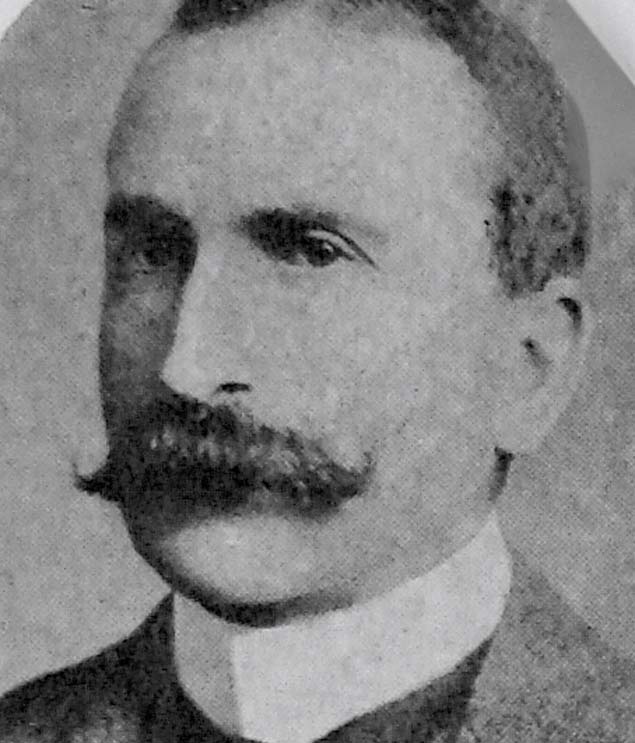 Victorian entrepreneur Sir John Arnott, who had two yachts entered in the first Kingstown to Queenstown Race of 1860
Victorian entrepreneur Sir John Arnott, who had two yachts entered in the first Kingstown to Queenstown Race of 1860
Arnott was always a man in a hurry, so it’s possible that he thought the distinguished flag officers of the Royal Cork were a bit conservative in their management. Thus he was one of a bunch of shaker-uppers who set up a new club in Cobh, the Queenstown Yacht Club, which they cleverly up-graded by taking on the tattered-remains of the old Royal Western of Ireland YC, founded in 1828 in Kilrush by Maurice O’Connell and his nephew Daniel of Derrynane among others, but wandering more or less homeless after the horrors of the Great Famine of 1845-47 had wiped out fripperies like yachting on Ireland’s Atlantic seaboard.
After a vague period in Dublin, suddenly the old Royal Western emerged re-born in 1861 in Cobh with Sir John Arnott as Commodore, and for their first season under this new arrangement, they showed nimbleness of foot by organising - at very short notice - a regatta to provide a race for this strange schooner which had suddenly arrived in their midst.
For although the schooner had the name of Camilla across her shapely transom, the dogs in the street in Queenstown knew that this was the one and only America, the 1851-built New York flyer which, by convincingly winning a rather hastily-assembled race round the Isle of Wight on the final day of Cowes Week 1851, had won a silver cup worth one hundred pounds sterling for her New York Yacht Club syndicate of owners.
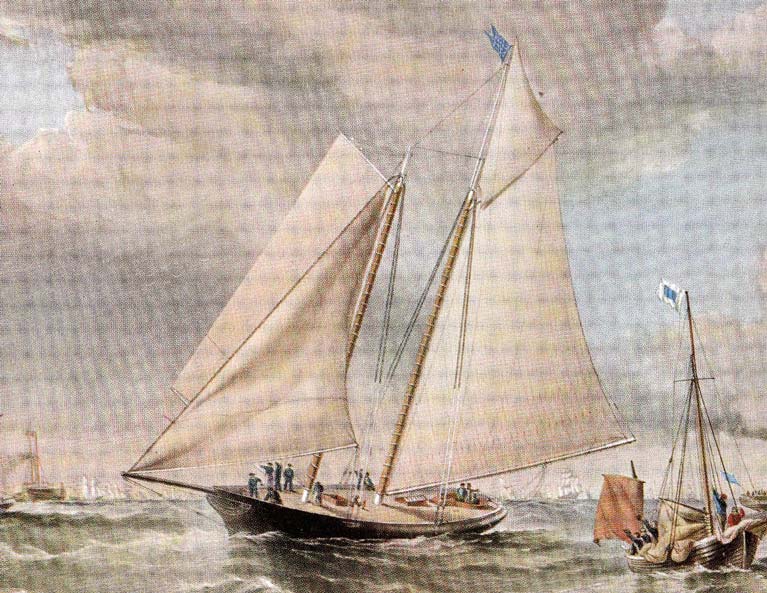 America wins, Friday, August 22nd 1851. Almost everything about her was different, including her notably flat-setting cotton sails, but she was soon being imitated
America wins, Friday, August 22nd 1851. Almost everything about her was different, including her notably flat-setting cotton sails, but she was soon being imitated The poster for Cowes Week 1851. The social pace was so hectic that they only had time for three races, and in the notice for Friday 22nd August, the inclusion of “yachts of the Clubs of all nations” was actually aimed at expected entries from the Imperial Yacht Club of St Petersburg in Russia. They failed to arrive, but in the meantime the schooner America had turned up, though she had to wait through the week until she could finally race on the Friday. From these only semi-planned beginnings, there emerged The America’s Cup.
The poster for Cowes Week 1851. The social pace was so hectic that they only had time for three races, and in the notice for Friday 22nd August, the inclusion of “yachts of the Clubs of all nations” was actually aimed at expected entries from the Imperial Yacht Club of St Petersburg in Russia. They failed to arrive, but in the meantime the schooner America had turned up, though she had to wait through the week until she could finally race on the Friday. From these only semi-planned beginnings, there emerged The America’s Cup.
In 1861 when the schooner was briefly in Cork, this rather unlovely cup – ewer is the technical name - was yet to become known as The America’s Cup, and there wasn’t to be a challenge to take it from the Americans until 1870. But ten years after her famous victory round the Isle of Wight, the myth and mystique of the schooner America was well established as part of world sailing lore, and the Young Turks in Cork sailing associated with John Arnott made the most of it, with this special schooner race quickly organised by the Royal Western of Ireland for June 28th, Camilla/America’s opposition being W D Seymour’s 85-ton La Traviata, W Wyse’s 140-ton Urania, and C H Smith’s “little” 66-ton Echo.
Camilla/America’s sails were tired and so were her crew, yet she still managed to take line honours in this slightly mysterious race. But it was by only one minute from the much-smaller La Traviata, which had been amateur-helmed by W D Seymour’s son to a clear handicap victory. After the finish, young Seymour was borne ashore shoulder-high by the cheering waterfront crowds to achieve a Cork Harbour sailing and sporting eminence to match that of Henry O’Bryen who – in a shrewd bit of window-dressing worthy of Arnott’s at their best - had been drafted in as Vice Commodore of the Royal Western of Ireland.
However, all these seemingly-rebellious Young Turks in the re-born RWIYC had retained their membership of the Royal Cork YC and would in time become part of its establishment lineup. But if they’d hoped to promote their “new” club by persuading the Camilla/America to take part in 1861’s staging of the Kingstown to Queenstown Race, they were disappointed, for as we shall see, the famous schooner had serious business elsewhere, and was soon gone.
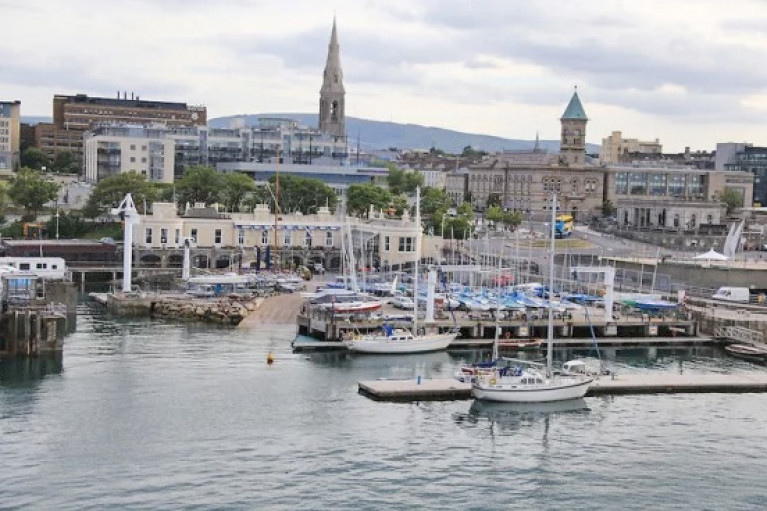 The Royal St George Yacht Club hosted the start of the first Dublin Bay to Cork Harbour race in 1860. Photo: Afloat.ie/David O’Brien
The Royal St George Yacht Club hosted the start of the first Dublin Bay to Cork Harbour race in 1860. Photo: Afloat.ie/David O’Brien
As it is, the 1861 race was started in Dublin Bay on 19th July, and once again mustered 16 starters with the winner being Colonel Huey’s slippy 62-ton cutter Osprey, with designer-builder Joseph Wheeler’s own 48-tonner Avalanche having to make do with second despite having led into Cork Harbour in light airs, while E J Saunderson of Lough Erne YC was third with another even smaller and slippy craft, the 34-ton cutter Phasma.
Admiral French’s own 61-ton yawl Spell took part this time (see first name on written entry list above), but although he was to continue as RCYC Admiral until his death in 1866, he’d already been 77 when he took over as Admiral in 1857, and his enthusiastic promotion of the Kingstown-Queenstown race’s first staging in 1860 suggested an old man in a hurry to promote an idea which he’d been carrying for some time.
Certainly, at its third staging on July 11th 1862, there’s a clear impression that others had taken it over, as the host club on Dublin Bay has become the Royal Irish YC from their impressive 1851-completed clubhouse, while the trophy is an expensive bit of silver plate presented by the Royal Western YC.
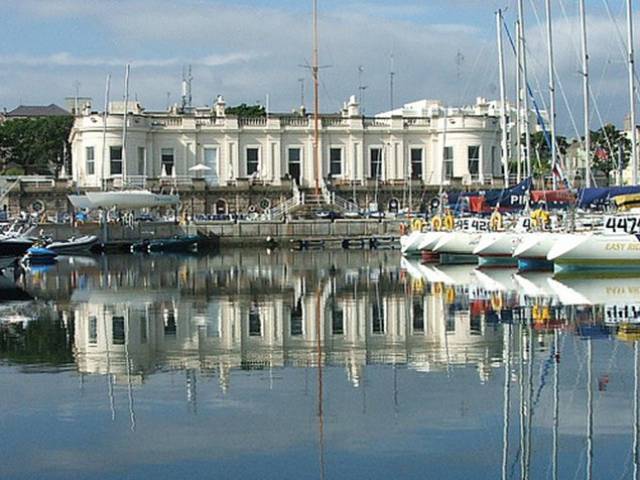 The Royal Irish Yacht Club hosted the start of the third and final Kingstown to Queenstown Race in 1862
The Royal Irish Yacht Club hosted the start of the third and final Kingstown to Queenstown Race in 1862
For anyone seeking abstruse historical connections, it’s of interest that The Liberator, Daniel O’Connell of Derrynane (1775-1847) had been present at both the foundation of the Royal Western in Kilrush in 1828, and the meeting in Dublin on July 4th 1846 when the 1831-founded Royal Irish YC had been revived. Meanwhile, in 1862, the Kingstown-Queenstown Race once again attracted 16 starters (though there’s no note of any entry limit), and they ranged in size from three 35-ton cutters – Ariadne (G Higgins), Coolan (G Robinson) and Glance (A Duncan – to two 130-ton schooner, Galatea (T Broadwood) and Georgiana (Capt Smith Barry).
The clear winner was the 50-ton cutter Phosphorous owned by W Turner - who is doubtless immortalized in modern Cork by Turner’s Cross - while C J Tennant’s 90-ton cutter Clutha was second on the water, but Galatea won the schooners and was reckoned second on handicap.
They arrived into the finish at Cobh where the Royal Western of Ireland was now well-established as the second club with premises at Westbourne Place next the Queen’s Hotel, and a membership which by 1863 included the Lord Lieutenant, Lord Carlisle, as well as Sir Robert Peel, at that time Chief Secretary for Ireland. So heaven only knows what politicking was going on behind the scenes, for the Royal Cork, still with T G French as Admiral, had been well settled into its purpose-designed new clubhouse (now the Sirius Arts Centre in Cobh) since 1854, and no-one doubted its claim of seniority in its descent from the Water Club of 1720.
As it happened, 1863 was probably the high point of the RWIYC’s time in Cobh, for the rest of the decade saw a period of economic decline, and the Dublin Bay to Cork Harbour Race wasn’t staged again. While the Royal Cork came through the thin times as it had come through many others, in 1870 the Royal Western of Ireland YC was quietly wound up at Cobh. But in the west of Ireland, and particularly with the Glynn family of Kilrush and The Knight of Glin across the Shannon Estuary, enough of its memorabilia, artefacts and records survived for it to be revived with the opening of Kilrush Marina, with the club’s greatest modern success being Ger O’Rourke’s overall victory with the Cookson 50 Chieftain in the RORC Rolex Fastnet Race 2007.
This may all seem to be something of an impenetrable maze of history, but it’s perfectly straightforward by comparison with the story of the schooner America, and how she came to be in Cork.
Everyone knows that she was hurriedly built early in 1851 in New York by Brown’s Shipyard, to the designs of the 31-year-old George Steers, for a swashbuckling syndicate of New York Yacht Club members led by John Cox Stevens. The project was to send a challenger across the Atlantic to race the English in Cowes Week at a time when the Great Exhibition in London was signalling the global achievements of the British Empire and its worldwide commercial success and dominance.
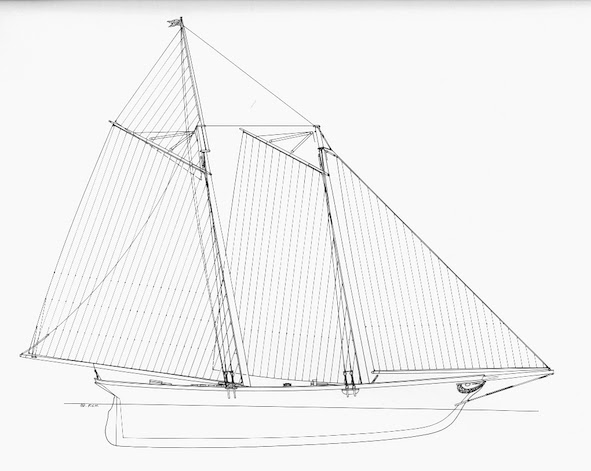 America as she was rigged when she won on August 22nd 1851. The boom on the jib broke during the race, which lost her about 15 minutes in repairs, but she was still well ahead at the finish.
America as she was rigged when she won on August 22nd 1851. The boom on the jib broke during the race, which lost her about 15 minutes in repairs, but she was still well ahead at the finish.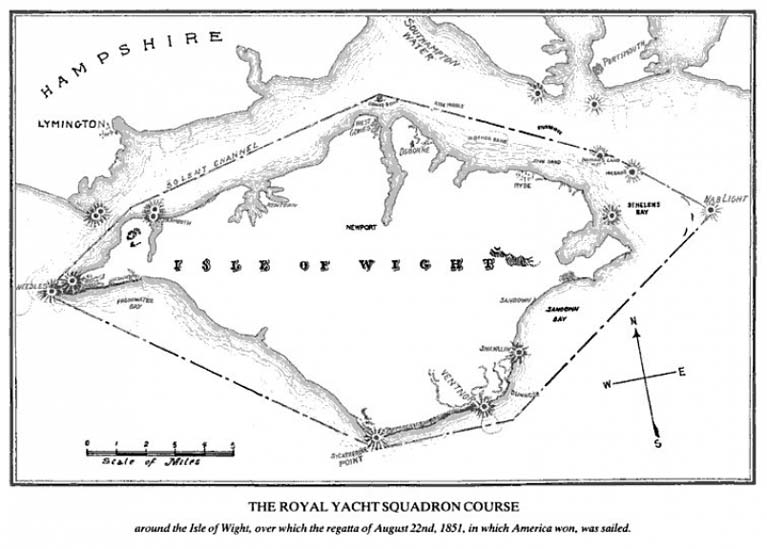 The 57-mile course for August 22nd 1851 – the Isle of Wight was rounded clockwise
The 57-mile course for August 22nd 1851 – the Isle of Wight was rounded clockwise
Not one of the top British racing yachts looked remotely like America, with her low rig and its raked masts, and her extremely hollow waterlines forward. But after she’d made her mark in a very distinctive fashion in just one race round the Isle of Wight on Friday, August 22nd 1851, several English racers were very expensively altered to take on board some of her ideas.
As for her American owners, they were gamblers to a man, so they collected their winnings, and celebrated mightily in New York, supported by their fellow-citizens to such an extent that grinchy Manhattan lawyer George Templeton Strong confided to his diary: “Newspapers crowing over the victory of Stevens’s yacht, which has beaten everything in the British seas. Quite creditable to Yankee shipbuilding, certainly, but not worth the intolerable, vainglorious vaporings that make every newspaper I take up now ridiculous. One would think yacht building were the end of man’s existence on earth”.
Quite so. Henry James would have been pleased with that. But as for America’s owners, they dropped ideas of sailing her home, and sold her in the Solent for 25,000 dollars to an Irish army officer of French Huguenot extraction, John de Blaquiere, who was soon to become the fourth Baron de Blaquiere of Ardkill in County Derry, where the family had thousands of acres acquired through their skills in tax gathering for the government, while the title came from supporting the Act of Union in 1801.
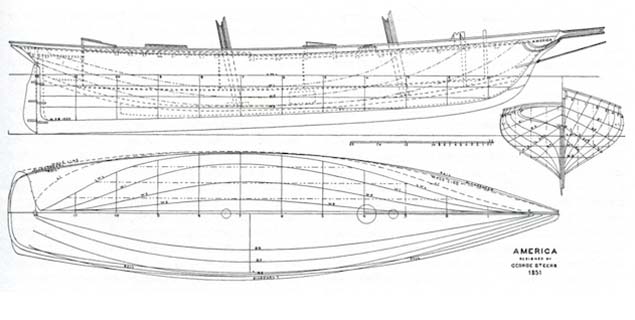 An amazingly well-balanced hull, with a rudder more like a trim tab. In her original form, America was steered by a small tiller, and the fact that her rudder stock had a very small rake forward may have helped her lightness of helm
An amazingly well-balanced hull, with a rudder more like a trim tab. In her original form, America was steered by a small tiller, and the fact that her rudder stock had a very small rake forward may have helped her lightness of helm
Despite these links, de Blaquiere never brought America to Ireland, but did some remarkable cruising to the Mediterranean, with the famous racing boat demonstrating her seagoing credentials by coming through a very severe storm off Malta in February 1852, while her legendary lightness of helm was eulogised by an experienced guest sailor: “Many yachtsmen will remember the almost mop-handle diminutiveness of her tiller, I steered her when going seven knots close-hauled and in some Bay of Naples swell, standing to leeward of the tiller and pressing against it with my little finger only”.
America’s hull was so sweetly balanced that her slim rudder was little more than a trim tab, but it was a trim tab made as effective as possible by being so vertical that the stock is almost inclined forward, unlike the unhealthy measurement-rule induced rudders of a later era, with their excessive and inefficient aft-raking of the stock.
Yet with all her virtues, as John Rousmaniere has commented in “The Low Black Schooner”, his brilliantly succinct account of this remarkable vessel, in the mid-1850s: “America was neglected because she had succeeded to the ambiguous status that is reserved for all trend-setters past their time.” However, in 1856 she was bought by yet another Irish peer from the north, this time Lord Templeton whose lands were in County Antrim, but he never brought America to Ireland either. In fact, he scarcely used her, though he did re-name her Camilla, and it was under this name that she was sold to ship-builder Henry Pitcher, who did extensive re-build work at his yard on the Thames.
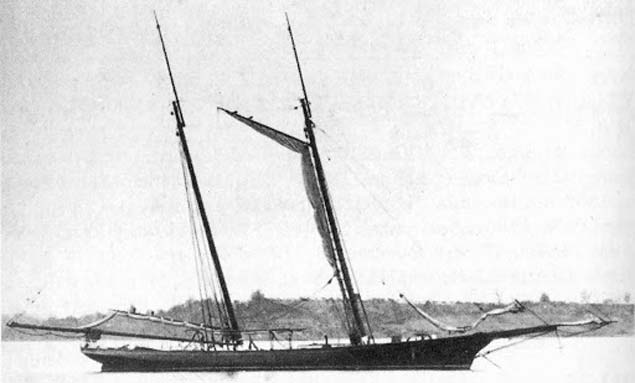 America’s rig underwent various forms in later life, and at one stage she had topmasts on both the main and fore masts, with the mainsail and the boomless foresail brailed up to their gaffs, the foresail’s gaff boom being left aloft. A retractable addition was also fitted to the bowsprit.
America’s rig underwent various forms in later life, and at one stage she had topmasts on both the main and fore masts, with the mainsail and the boomless foresail brailed up to their gaffs, the foresail’s gaff boom being left aloft. A retractable addition was also fitted to the bowsprit.
He then sold her in 1860 to a “mysterious character” called Henry Edward Decie, supposedly a 28-year-old former officer in the Royal Navy, where they’d been obliged to let him go, as they say in HR circles, because he’d been excessively zealous in chasing pirates on the coast of South America, and had knocked lumps out of a Brazilian warship by mistake.
Maybe so. At least that was his story, but we’re into murky waters here, and things were becoming even murkier in the USA with the Civil War looming. A dodgy character like Decie with a super-fast boat like Camilla ex-America - with her proven transatlantic capacity - was just what the Confederate States were looking for in assembling a fleet of fast blockade runners.
Henry Decie seems to have been Captain Cool, and he certainly loved sailing. Family cruising too. In August 1860, having won a race in a regatta at Plymouth, Camilla sailed away with Henry Decie and his wife or maybe she was his mistress and her six children and a crew of thirteen (nothing superstitious about our Henry), and after calling at several places including Lisbon and the Cape Verde Islands, on April 21st 1861 she fetched up on the other side of the Atlantic at Savannah, Georgia. There, the rebel Confederate Government had her bought within a month for 60,000 dollars on condition that Decie remained in charge, and undertook a voyage to Europe with a mission to purchase armaments and organize the building of warships.
So the former schooner America set off back to Europe still under the command of Henry Decie on the 25th May 1861 for her third Atlantic crossing, and on board with Decie and his shipmates were two Confederate Agents with Bills of Exchange to the tune of 600,000 dollars, plus Letters of Credit for much more. This was serious stuff. Yet on June 23rd it was as a light-hearted cruising vessel that she arrived into Cork Harbour, claiming the immunity and privileges conferred by her Royal Victoria Yacht Club burgee and British ensign, with Decie saying that he’d just strolled over from Cowes for a little competition.
 The modern port of Savannah in Georgia, USA. The schooner Camilla ex-America departed Transatlantic from here on 25th May 1861, but when she arrived in Cork Harbour on June 23rd, her skipper Henry Decie claimed they’d just sailed over from Cowes.
The modern port of Savannah in Georgia, USA. The schooner Camilla ex-America departed Transatlantic from here on 25th May 1861, but when she arrived in Cork Harbour on June 23rd, her skipper Henry Decie claimed they’d just sailed over from Cowes.
That was duly arranged in jig time by the Royal Western Yacht Club of Ireland in Cobh. We can only guess as to who really knew what was going on. The two Confederate agents soon disappeared into the bustle ashore and onward on their mission, and Henry Decie and the Cork Harbour schooners went yachting, but then he had to depart again within a day or to rendezvous with the agents.
In time, Camilla reverted to being America, and she finished the Civil War serving on the Union side. In various ownerships and eventually, in the charge of the US Navy, she survived until 1945. But the 100,000 dollars which President Franklin D Roosevelt had allocated for the maintenance of the old girl never reached her in the hectic end-of-war period, and in 1945 the roof of the shed she was housed in collapsed under a freak fall of snow, and that was the end of the wonderboat of 1851 which had briefly been a sensation when she sailed into Cork Harbour in 1861.



























